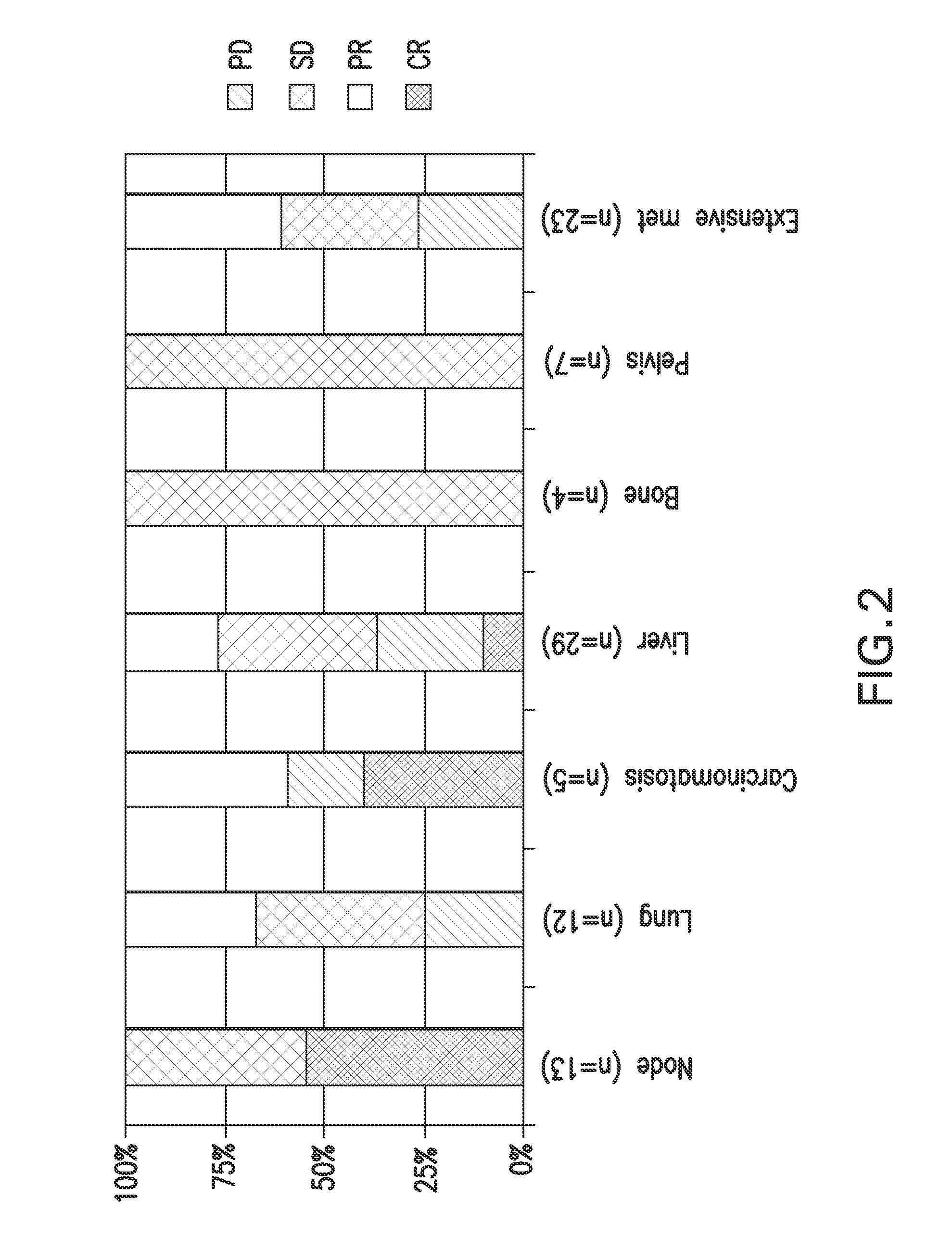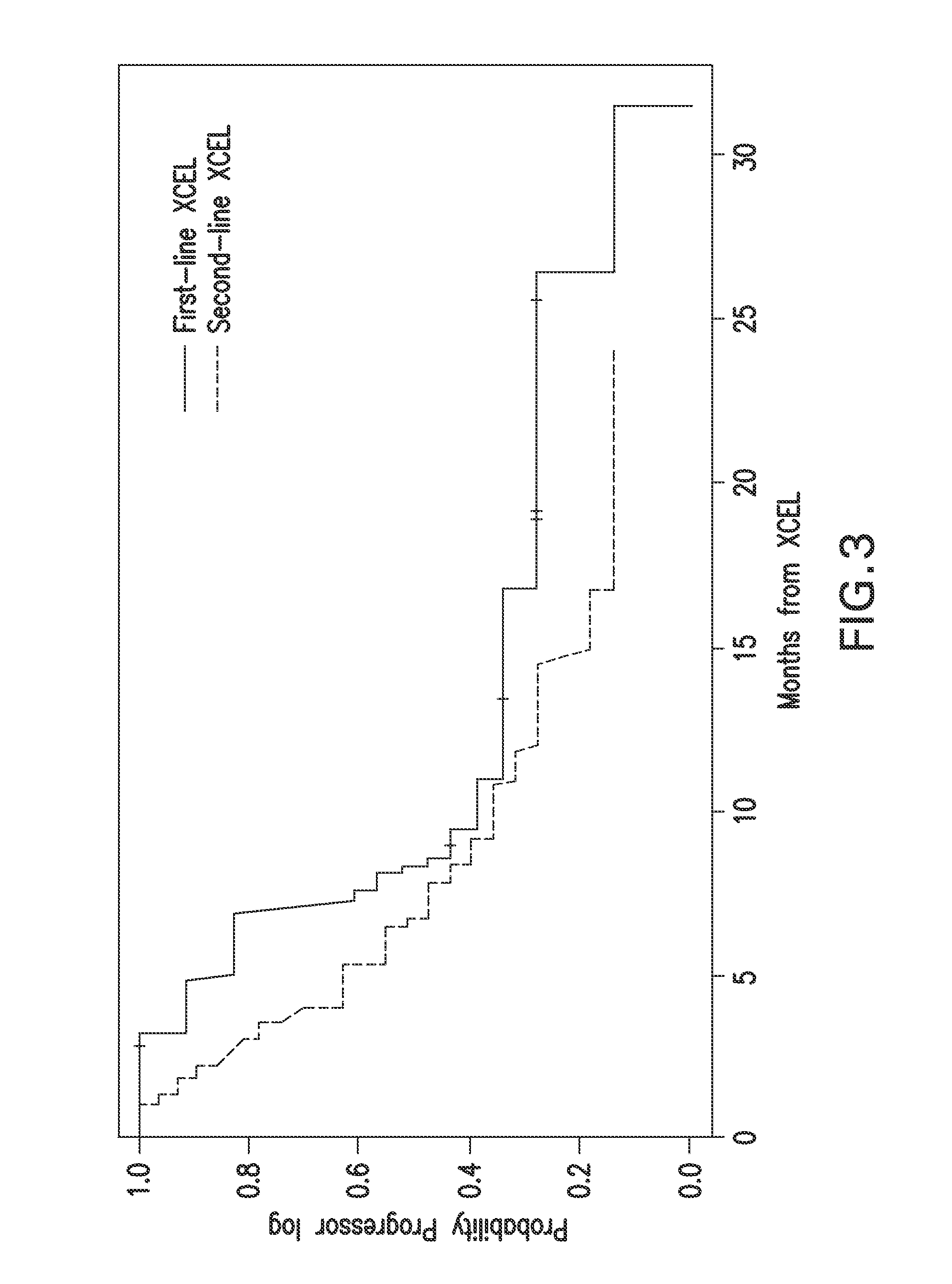Method for determining complete response to anticancer therapy
- Summary
- Abstract
- Description
- Claims
- Application Information
AI Technical Summary
Benefits of technology
Problems solved by technology
Method used
Image
Examples
example 1
Materials and Methods for Study 1
[0124]Patients
[0125]The institutional review board of The University of Texas M. D. Anderson Cancer Center approved this retrospective expanded cohort study. Between October 2000 and December 2003, seventy-four patients with metastatic colorectal cancer received capecitabine with concurrent celecoxib (n=66), or rofecoxib (n=2), ibuprofen (n=2), sulindac (n=2) and high dose aspirin (n=2). This study analyzed sixty-six patients who received capecitabine and celecoxib (XCEL).
[0126]Treatment
[0127]Patients who did not receive concurrent radiation therapy received capecitabine orally at a dose of 1000 mg / m2 / d twice daily (b.i.d) for 14 days every 21 days, except for four patients who started at 1250 mg / m2 / d b.i.d and six elderly patients who started at 900 mg / m2 / d b.i.d. All 34 patients who received radiation therapy received capecitabine at 1000 mg / m2 / d b.i.d. Monday through Friday during radiation and continued capecitabine at 1000 mg / m2 / d b.i.d. for 14 ...
example 2
The Effects of Combination Therapy (Study 1)
[0132]The patients' baseline clinical and treatment characteristics are summarized in Table 1. The median age of the 24 patients who received first-line XCEL was 73 years (range, 45-86 years), and 7 patients were 78 years or older. Of the 42 patients who received XCEL as second-line therapy, 9 were still responding to the first-line treatment or sensitive to irinotecan-based treatment, the remaining 33 patients' disease had progressed during the first-line treatment. Twenty-four (71%) of the 34 patients who received radiation had prior first-line chemotherapy.
TABLE 1Baseline Patient, Disease, and Treatment Characteristics (n = 21)CategoryNo. of patients (%)Median age (range)64 (30-82 years)11 (52)≧64 years10 (48)SexMale13 (62)Female8 (38)RaceWhite21 (100)Eastern CooperativeGroup (ECOG) performance status012 (68)18 (38)21 (5)Primary colon cancer14 (67)Primary rectal cancer7 (33)Initial AJCC StagesII4 (19)III8 (38)IV9 (43)Median disease free...
example 3
Materials and Methods for Study 2
Patients and Treatment
[0145]This retrospective study was approved by the institutional review board of The University of Texas M. D. Anderson Cancer Center. All sixty-six patients received concurrent capecitabine (Xeloda, Roche Nutley, N.J.) at mean daily dose 1000 mg / m2 / d bid for 14 days every 21 days or Monday-through Friday with radiation with daily celecoxib (CELEBREX®, Pfizer, N.Y.) at 200 mg PO b.i.d. from October 2000 to December 2003.
[0146]Evaluation and Definitions
[0147]All patients were subjected to routine clinical examinations, laboratory analyses, and computed tomography before receiving XCEL described previously. All patient data were to be independently audited and radiographic images depicting CR were reviewed and agreed upon by two independent radiologists. All 19 patients had pathological confirmation of metastatic cancer ( ). Treatment-related toxicity was graded using the National Institutes of Health's Common Terminology Criteria...
PUM
| Property | Measurement | Unit |
|---|---|---|
| Level | aaaaa | aaaaa |
Abstract
Description
Claims
Application Information
 Login to View More
Login to View More - R&D
- Intellectual Property
- Life Sciences
- Materials
- Tech Scout
- Unparalleled Data Quality
- Higher Quality Content
- 60% Fewer Hallucinations
Browse by: Latest US Patents, China's latest patents, Technical Efficacy Thesaurus, Application Domain, Technology Topic, Popular Technical Reports.
© 2025 PatSnap. All rights reserved.Legal|Privacy policy|Modern Slavery Act Transparency Statement|Sitemap|About US| Contact US: help@patsnap.com



